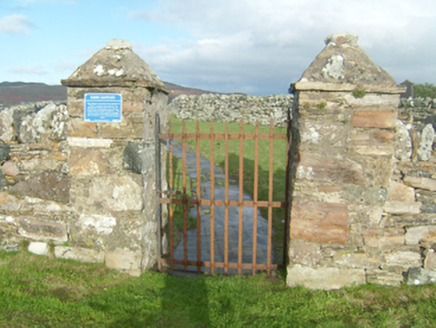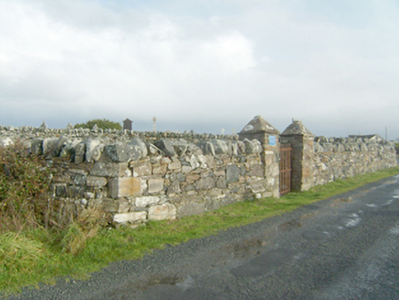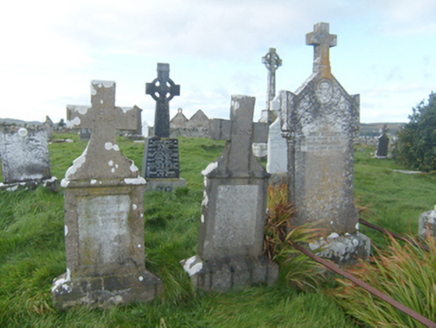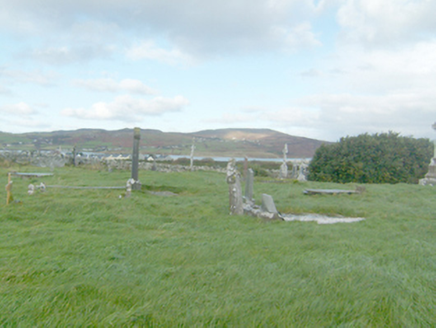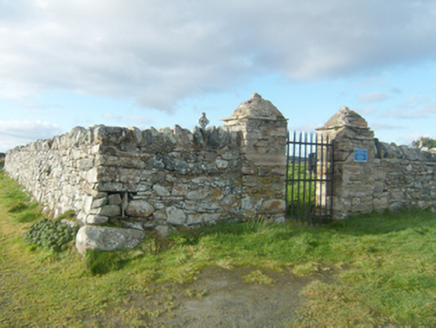Survey Data
Reg No
40901521
Rating
Regional
Categories of Special Interest
Archaeological, Artistic, Historical, Social
Original Use
Graveyard/cemetery
Date
1750 - 1950
Coordinates
202292, 436701
Date Recorded
15/11/2010
Date Updated
--/--/--
Description
Group of three graveyards (on sub rectangular-plans), in use c. 1760 until c. 1940, comprising a paupers’ graveyard to the west and with Catholic and Church of Ireland graveyards to the east. Pauper’s graveyard contains mainly unmarked graves associated with Dunfanaghy Union Workhouse (see 40807008) to the north-west, and a number of iron crosses commemorating individuals drowned at sea. Timber cross and memorial stone to pauper's graveyard. Catholic graveyard contains collection of mainly upstanding monuments of nineteenth and twentieth century date, some with metal railed enclosures. Earliest legible gravemarker commemorates Neal Tuohy (?), dated July 1778. Church of Ireland graveyard contains collection of mainly upstanding twentieth-century gravemarkers; earliest gravemarker dated 1881. Site surrounded by rubble stone boundary walls with rubble stone solider coping over. Gateway to paupers’ graveyard to the south comprising a pair of rubble stone gate piers (on square-plan) having rubble stone coping over, and with wrought-iron flat bar gate. Gateway to Catholic and Church of Ireland graveyards to the south-east corner of site having comprising a pair of rubble stone gate piers (on square-plan) having rubble stone coping over, and with wrought-iron flat bar gate. Former penal mass station (see RMP DG015-017001-), c. 1750, built up against the outside wall to the east boundary comprising masonry platform. Located in the rural countryside to the south-west of Dunfanaghy. Former church and graveyard (see 40901517) to the west.
Appraisal
An interesting group of graveyards that creates an atmosphere site in the rugged and scenic rural landscape to the south-east of Dunfanaghy. The graveyard to the west appears to be the earliest part of the complex with the earliest legible gravemarker dated July 1778, commemorating a Neal Tuohy (?). It is likely that there are earlier illegible and unmarked graves in this section. It also contains a number of later nineteenth- and twentieth century Celtic cross and carved stone memorials of modest artistic merit. A number of memorials also have metal railed enclosures with intricate cast-iron fittings, which creates additional interest. This section of the graveyard also contains a separate section of Church of Ireland internments of mainly twentieth-century date (earliest dated 1881). A rubble stone platform built against the outside of the boundary wall to the east side of the graveyard was apparently a penal mass station (see RMP DG015-017001-), and probably dates to c. 1750 or, perhaps, earlier. The Ordnance Survey Name Book of c. 1905, compiled at the time field work was being carried out in preparation of the twenty-five inch map series, records that clergymen stood on this platform when officiating at burials to collect death offerings. Of particular note and interest is the ‘paupers’ graveyard’ to the west side of the complex, contained in a separate rubble walled enclosure. It largely contains the unmarked graves of victims of the Great Famine (1845-51) who died at Dunfanaghy Union Workhouse (see 40807008), which is located a short distance to the north-west. It is marked by a simple modern timber cross and a modern memorial stone, and now acts as a moving reminder of this traumatic event in Irish history. Its preservation and maintenance demonstrates the local significance placed on the site, not least in providing a poignant area of reflection. Dunfanaghy Union Workhouse was originally built to standard designs by George Wilkinson at a cost of £4,350 for the buildings and £855 for the fittings. It was designed to accommodate 300 inmates and first admissions took place on the 24th of June 1845. Although designed to accommodate 300, the workhouse was grossly overcrowded during the Famine with outbreaks of dysentery and other fevers common; it is likely that there are hundreds, if not thousands, of individuals interred here. This ‘paupers’ graveyard’ also contains a number of simple iron crosses that mark the graves of ‘strangers drowned at sea’. Dunfanaghy was a thriving commercial fishing port throughout the nineteenth century, encouraged and supported by the Stewart family of Ards demesne, the proprietors of the town and of vast estate in the area at the time. The port was used for the provision of supplies to a Scottish fishing fleet that operated locally at the start of the nineteenth century. This fleet suffered a major catastrophe in 1818 when a storm swamped many of the boats whilst out fishing. Many of the boats that made for the shelter of Dunfanaghy harbour were smashed to pieces on the sandbar at the tip of the inlet of Sheephaven Bay. Apparently only one of over a hundred boats made it safely to port. The crews of the other boats were lost, their bodies washing up around the harbour over the coming days. It is likely that many hundreds were lost in this disaster, and at least some of the victims were buried here. This fascinating site, of social and historical interest, is an important addition to the history and folk memory of the local area. The simple rubble stone walls, and gateways with rubble stone gate piers and wrought-iron gates, add to the setting and context. It forms a pair of sites with the former church and graveyard (see 40901517) located adjacent to the west.
